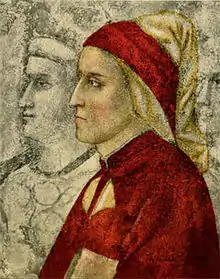Laborintus II (album)
Laborintus II is a joint album by the Belgian orchestra Ictus Ensemble, the vocal group Nederlands Kamerkoor and the American vocalist Mike Patton, which was recorded live at the 2010 Holland Festival. It was released on July 10 2012 by Ipecac Recordings, and debuted at number 23 on the American Billboard Classic Albums chart. It received mixed reviews from critics.
| Laborintus II | ||||
|---|---|---|---|---|
 | ||||
| Live album by | ||||
| Released | July 10, 2012 | |||
| Recorded | June 18, 2010 | |||
| Length | 32:09 | |||
| Language | Italian, English[1] | |||
| Label | Ipecac Recordings (IPC-133) | |||
| Producer | Mike Patton, Greg Werckman, Lieven Bertels, Jean-Luc Plouvier | |||
| Mike Patton chronology | ||||
| ||||
The album is a recording of the 1965 work of the same name by Italian composer Luciano Berio, and contains lyrics from Edoardo Sanguineti's 1956 poem Laborintus. Berio's composition employs elements of jazz and electronic music. Sanguineti's libretto borrows ideas from the works of Dante Alighieri, T. S. Eliot and Ezra Pound, and uses his own original work. Berio named "memory, death and usury" the work's main concerns, believing these themes to be present in Dante's work.
Production
Laborintus II is a recording of a 1965 composition by Luciano Berio, written to celebrate the 700th anniversary of Dante Alighieri's birth.[2] The libretto was provided by Edoardo Sanguineti,[3] who included elements of his 1956 poem Laborintus in it. AllMusic's Thom Jurek described the original poem as speaking of "the timelessness of love and mourning, while acting as a critique of the commoditization of all things".[4] In addition to Sanguineti's own poetry—itself based on themes found in Dante's Divina Commedia, Convivio and La Vita Nuova—the work uses excerpts from the Bible and the writings of poets T. S. Eliot and Ezra Pound. Musically, Laborintus II incorporates elements of jazz and electronic music while sometimes evoking the style of Italian composer Claudio Monteverdi.[2]
Berio described the main structure as a "catalogue, in its medieval meaning" (exemplified by Isidore of Seville's seventh century encyclopaedia Etymologiae), using Dante's themes of "memory, death and usury".[3] Members of the Dutch choir Nederlands Kamerkoor, who performed on the recording, have also cited usury as a key theme in the work, describing the composition as "an indictment against the practice".[nb 1][5] Of the form, Berio wrote: "Individual words and sentences are sometimes to be regarded as autonomous entities, and sometimes to be perceived as part of the sound structure as a whole."[3] The instrumentation for Laborintus II was written as an "extension" of the vocal material; its electronic section is likewise an extension of the instrumental music.[3] Berio used car tyres and a blow-up doll on stage in a performance of the work at the Holland Festival in 1973.[6]
The album was recorded live at the Holland Festival on June 18, 2010, in the Muziekgebouw aan 't IJ. The work was performed by Mike Patton and the Belgian Ictus Ensemble conducted by Georges-Elie Octors. Solos were performed by Ictus Ensemble clarinetist Dirk Descheemaeker, trumpeter Loïc Dumoulin, trombonist Michel Massot, double bass player Géry Cambier, and percussionists Michael Weilacher and Gerrit Nulens.[7] Nederlands Kamerkoor provided the choral accompaniments. The album marks only the third recording of the composition to have been released since it was first broadcast on French radio by Office de Radiodiffusion Télévision Française.[8] Patton has said of the work, "I can listen to Berio and Nono as easily as I can to Morricone but like all modern music of Italy, it is unfortunately marginalized ... Maybe because of the language barrier, maybe because it’s not easily understood. Berio, who was teaching in California when he wrote this piece, was listening to jazz, pop and folk music and incorporated all of it in his works without prejudice".[6]
Composition


Laborintus II combines orchestral, choral and spoken elements throughout its three parts.[9][10] Patton's narration is spoken in Italian,[4] although taped samples feature Sanguineti speaking in English.[1] Patton uses a range of vocal techniques—including whispering, singing and shouting—as the work progresses. The choral parts respond to the narration both with unified chanting and with disjointed arguing; the overall effect is one of "dramatic tension".[4] They are accompanied by three female vocalists[9] whose voices range from soprano singing[10] to "cooing" and "howling".[4]
The music incorporates elements of jazz[2][9] and 20th-century avant-garde.[10] The orchestra's instruments frequently interrupt both each other and the female voices;[9] some sections of the composition seem as though they are improvised.[4] Laborintus II makes use of both traditional percussion instruments and electronic sounds, and their interplay serves to "erect musical and textural architectures, then disassemble them quickly".[4] Critic Max Feldman has compared the style to that of Raymond Scott.[9]
The first part of the composition features the three female voices creating a "mournful" tone while the orchestra plays recurring musical passages.[11] The second part is a discordant crescendo,[11] as Patton's narration becomes increasingly shouted and the orchestral accompaniment more "hyperactive".[9] The third and final part returns to a calmer tone, focusing on drums and jazz woodwind instruments.[11]
Release and reception
| Aggregate scores | |
|---|---|
| Source | Rating |
| Metacritic | 58[12] |
| Review scores | |
| Source | Rating |
| AllMusic | |
| The A.V. Club | B−[11] |
| Consequence of Sound | |
| PopMatters | |
| Spin | |
| Sputnikmusic | |
Laborintus II was released on July 10, 2012, through Patton's record label Ipecac Recordings.[4] In the United States, the album debuted and spent one week on the Billboard Classic Albums chart at number 23.[15]
The album was not well received by critics. Review aggregation website Metacritic awarded it an average score of 58 out of 100, based on eight reviews; this indicates "mixed or average reviews" by their metric.[12] For the most part, reviewers have considered the album to be challenging and difficult, with some believing it to be an acquired taste after repeated listens and others deeming it impenetrable. The A.V. Club considered the recording to be "challenging, uncompromising, and bordering on inaccessible", but credited it with "hidden payoffs" to reward repeated hearings, including "haunting" and "wraithlike" arrangements.[11] Sputnik Music echoed this view but described the album as "fascinating if not unwieldy", and the composition itself as "somber, beautiful, and ominous, but always affecting"; they felt that Laborintus II was perhaps Patton's most ambitious album to date, but noted that the musician has previously produced similarly avant-garde records in the past.[10] AllMusic—while highlighting that Laborintus II was difficult to grasp at first, by virtue of being a recording of theatrical music—described the recording as "a very nearly dazzling endeavor that rewards patience mightily".[4] Consequence of Sound's called it "unlike anything else you’ve ever heard",[13] noting the music might need more than one hearing to appreciate it, and that it "runs the gauntlet from quiet, jazzy atmospherics to brazen, unsettling primal noise".[13]
A review for PopMatters stressed the "challenging" and "exhausting" nature of Berio's composition, adding that the music "constantly emphasises its own unpredictability". It compared the album to the 1970 Miles Davis free jazz album Bitches Brew.[9] Spin magazine's review described it as being "narrated by a rock star prone to screaming",[14] while a reviewer for Q magazine called it "both disorienting and immensely tedious".[16] The complex nature of the piece was summed up by Magnet magazine, whose reviewer felt that it was "hard not to respect Patton's creative adventurousness, but sweet Jesus, the gulf between admiration and enjoyment of one of his projects has never been so wide".[16]
Ictus Ensemble's performance was singled out for praise by AllMusic, writing of their "bracing freshness and mischievous glee".[4] Likewise Patton's voice frequently attracted comments by critics who variously described it as "grim, medieval, almost priestly",[9] "alternately authoritative and declarative, reflective, romantic, priestly, and nearly apocalyptic",[4] and "a unique tool that he can shape into whatever he needs it to be".[13]
Track listing
All lyrics are written by Edoardo Sanguineti; all music is composed by Luciano Berio.
| No. | Title | Length | |
|---|---|---|---|
| 1. | Untitled | [nb 2] | 11:38 |
| 2. | Untitled | 15:03 | |
| 3. | Untitled | 5:28 | |
| Total length: | 32:09 | ||
Personnel
_(4416923516).jpg.webp)
- Luciano Berio – composer
- Edoardo Sanguineti – libretto
- Georges-Elie Octors – conductor
- Mike Patton – narrator
- Nederlands Kamerkoor – choir
- Annet Lans – voice
- Margriet Stok – voice
- Karin van der Poel – voice
- Klaas Stok – chorus master
- Michael Schmid – flute
- Dirk Descheemaeker – clarinet
- Carlos Galvez – clarinet
- Dries Tack – clarinet
- Samia Bousbaïne – harp
- Jutta Troch – harp
- Philippe Ranallo – trumpet
- Michaël Tambour – trumpet
- Loïc Dumoulin – trumpet
- Alain Pirre – trombone
- Michael Massot – trombone
- Nicholas Villers – trombone
- Geert De Bièvre – cello
- Françoise Deppe – cello
- Géry Cambier – double bass
- Michael Weillacher – percussion and drums
- Gerrit Nulens – percussion and drums
Notes
Footnotes
- Album notes, pp. 12–21.
- Posarelli, Umberto. "Laborintus II, for 3 voices, 8 actors, speaker, ensemble & tape". Allmusic. AllMusic. Archived from the original on October 11, 2015. Retrieved January 4, 2013.
- Berio, Luciano. "Laborintus II (author's note)". Archived from the original on September 20, 2013. Retrieved January 4, 2013.
- Jurek, Thom. "Listen to Luciano Berio: Laborintus II by Ictus Ensemble – Album Reviews, Credits, Awards". Allmusic. Archived from the original on July 14, 2012. Retrieved August 15, 2012.
- "Holland Festival: Laborintus II" (in Dutch). Nederlands Kamerkoor. Archived from the original on February 22, 2013. Retrieved January 5, 2013.
- Roffman, Michael (May 2, 2012). "Mike Patton honors Luciano Berio with Laborintus II". Consequence of Sound. Archived from the original on August 28, 2012. Retrieved August 18, 2012.
- Album notes, p. 1.
- Album notes, p. 2.
- Feldman, Max (July 2, 2012). "Mike Patton & Ictus Ensemble: Laborintus II". PopMatters. Archived from the original on August 15, 2012. Retrieved August 15, 2012.
- Kleman, Eli (July 23, 2012). "Mike Patton and Luciano Berio Laborintus II (staff review)". Sputnikmusic. Archived from the original on August 25, 2012. Retrieved August 15, 2012.
- Mincher, Chris (July 3, 2012). "Mike Patton: Laborintus II | Music | MusicalWork Review". The A.V. Club. Archived from the original on August 18, 2012. Retrieved August 15, 2012.
- "Luciano Berio: Laborintus II Reviews, Ratings, Credits, and More". Metacritic. Archived from the original on October 21, 2012. Retrieved January 4, 2013.
- O'Shoney, Carson (July 3, 2012). "Album Review: Mike Patton – Laborintus II". Consequence of Sound. Archived from the original on August 7, 2012. Retrieved August 15, 2012.
- Weingarten, Christopher R. (July 9, 2012). "Mike Patton, 'Laborintus II' (Ipecac)". Spin. Archived from the original on September 24, 2015. Retrieved February 27, 2020.
- "Mike Patton Luciano Berio: Laborintus II – Chart history". Billboard. Prometheus Global Media. Archived from the original on February 13, 2020. Retrieved February 13, 2020.
- "Critic Reviews for Luciano Berio: Laborintus II". Metacritic. Archived from the original on July 17, 2012. Retrieved January 4, 2013.
- Album notes, pp. 1–22.
Bibliography
- Rossi, Melissa; Bertels, Lieven; Plouvier, Jean-Luc (2012). Laborintus II (booklet). Mike Patton and Ictus Ensemble. Alameda, California: Ipecac Recordings. IPC-133.